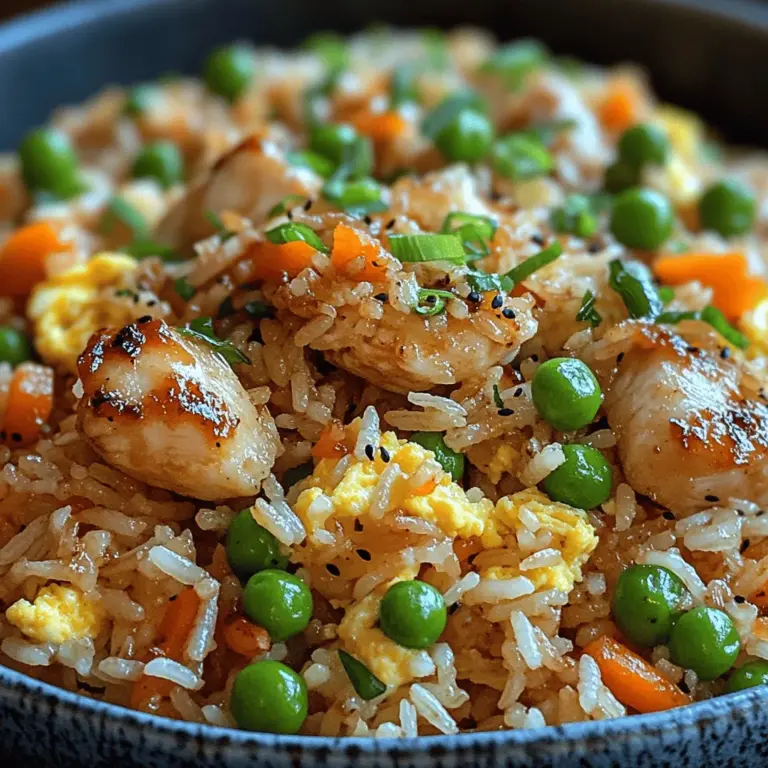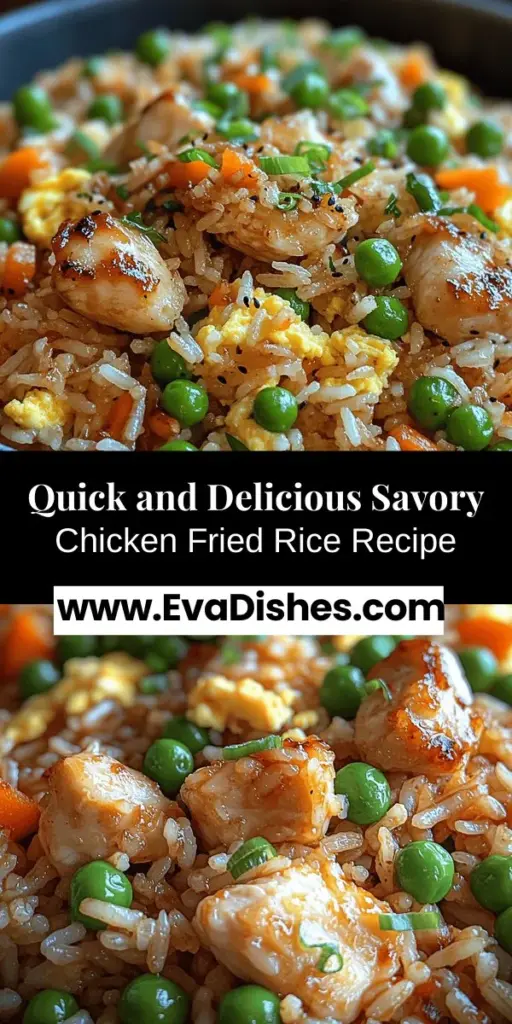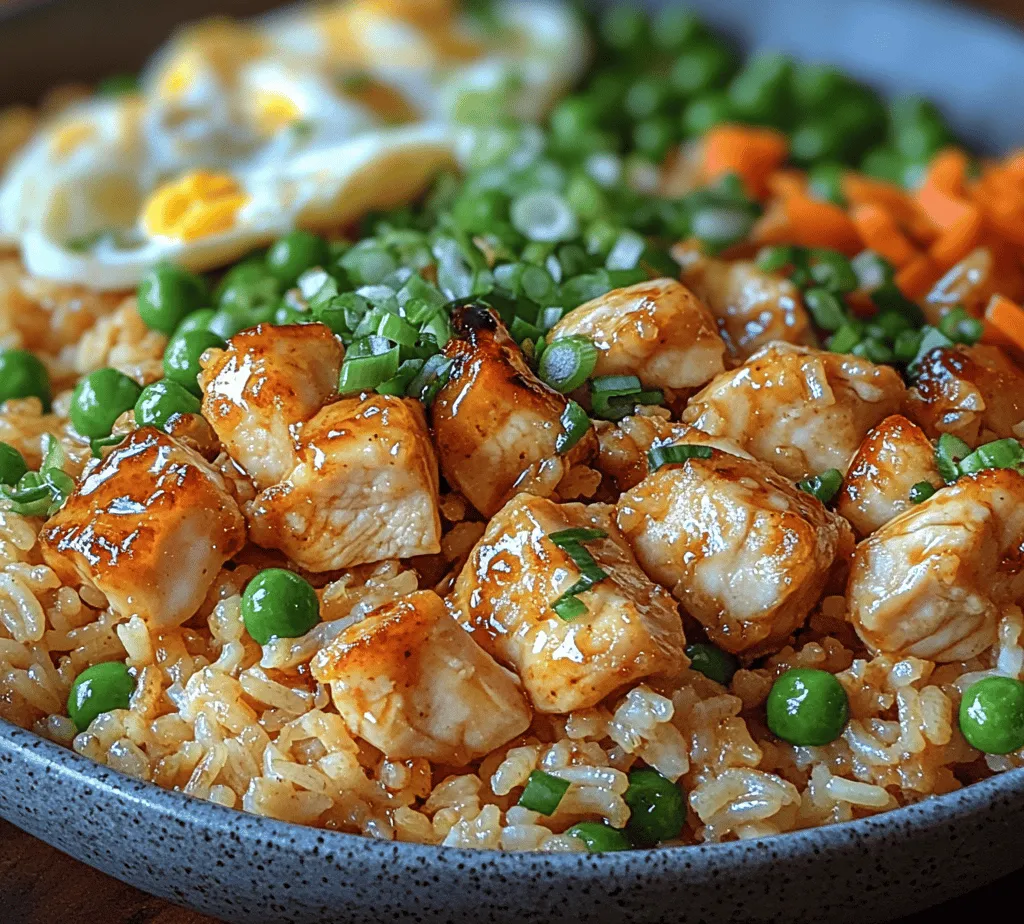Introduction
Fried rice is more than just a dish; it’s a beloved staple that has found its way into kitchens across the globe. From the bustling streets of Southeast Asia to home kitchens in the Western world, fried rice serves as a canvas for a myriad of flavors and ingredients. Its popularity can be attributed to its simplicity, versatility, and comforting taste that transcends cultural boundaries.
Among the many variations of fried rice, Savory Chicken Fried Rice Delight stands out as a perfect blend of tender chicken, vibrant vegetables, and aromatic seasonings. This dish is not only a delightful treat for your taste buds but also a wholesome meal that can be prepared in under 30 minutes, making it an ideal choice for busy weeknights or casual gatherings with friends and family.
One of the key secrets to achieving the perfect fried rice lies in the use of day-old rice. Freshly cooked rice tends to be too moist, resulting in a mushy texture when stir-fried. Day-old rice, on the other hand, has dried out slightly, allowing it to absorb flavors and maintain a satisfying bite. This simple tip is crucial for home cooks eager to master the art of fried rice.
In addition to its delightful flavor, Savory Chicken Fried Rice Delight boasts a range of nutritional benefits. The combination of chicken, eggs, and fresh vegetables creates a balanced meal rich in protein, vitamins, and minerals. With the right ingredients, you can create a dish that is not only delicious but also nourishing.
Understanding Fried Rice: A Culinary Staple
To appreciate the depth of fried rice, it’s essential to explore its history and variations around the world. Fried rice is believed to have originated in China around the 6th century, where it was a way to utilize leftover rice and ingredients. The concept quickly spread throughout Asia, with each culture adding its unique twist.
In Chinese cuisine, fried rice often features ingredients like shrimp, pork, or chicken, combined with vegetables and soy sauce. Thai fried rice, known as “Khao Pad,” incorporates fragrant jasmine rice and is often flavored with fresh herbs and spices, including lime and chilies. In Indonesia, fried rice becomes “Nasi Goreng,” often served with fried eggs and a variety of spices, showcasing the local palate’s bold flavors.
The significance of fried rice extends beyond its cultural roots; it represents a balanced meal comprising protein, carbohydrates, and vegetables. This balance makes fried rice not only satisfying but also a practical choice for those looking to incorporate various food groups into one dish.
Key Ingredients for Savory Chicken Fried Rice Delight
Creating the perfect Savory Chicken Fried Rice Delight requires a thoughtful selection of ingredients. Each component plays a vital role in achieving the dish’s signature flavor and texture. Let’s delve into the essential ingredients that contribute to this culinary masterpiece.
Jasmine Rice
At the heart of any fried rice dish is the rice itself, and in this recipe, jasmine rice is the star. Known for its fragrant aroma and slightly sticky texture, jasmine rice is a long-grain variety that cooks to a fluffy consistency. This quality helps the rice grains remain separate when stir-fried, making it an ideal choice for fried rice. The subtle floral notes of jasmine rice also elevate the overall flavor of the dish, adding an aromatic dimension that complements the savory components.
Boneless, Skinless Chicken Thighs
While many recipes call for chicken breasts, boneless, skinless chicken thighs are preferred in this dish for several reasons. Thighs are generally more flavorful and tender than breasts, which can become dry when cooked. Their slightly higher fat content contributes to a richer taste, ensuring that each bite is juicy and satisfying. Additionally, chicken thighs are often more economical, making them a practical choice for home cooks looking to create a delicious meal without breaking the bank.
Vegetable Oil
The choice of cooking oil can significantly impact the overall flavor and texture of your fried rice. Vegetable oil is a popular option for frying due to its high smoke point, which allows for high-temperature cooking without burning. This is essential for achieving the perfect stir-fried texture. Alternatively, you can use oils like canola or grapeseed, which also have high smoke points. For those looking to infuse additional flavors, oils such as peanut or sesame oil can be used in combination with vegetable oil.
Eggs
Eggs play a crucial role in fried rice, providing both protein and richness to the dish. When scrambled and mixed with the rice, eggs not only enhance the dish’s nutritional profile but also contribute to its creamy texture. The addition of eggs also adds a beautiful golden hue, making the dish visually appealing. For a vegetarian version, you can opt for scrambled tofu as a substitute.
Frozen Peas and Carrots Mix
Using a frozen peas and carrots mix is a convenient way to introduce color and nutrition to your fried rice. These vegetables are rich in vitamins A and C, as well as fiber, making them a healthy addition. The frozen variety ensures that you can enjoy the dish year-round without concern for seasonal availability. Simply toss them in during the cooking process, and they will thaw and integrate perfectly into the dish.
Onions and Garlic
No savory dish is complete without aromatics, and in this recipe, onions and garlic serve as flavor enhancers. Onions provide a sweet and savory base, while garlic infuses the dish with its unmistakable aroma and taste. Both ingredients are known for their health benefits, including anti-inflammatory properties and immune support. Sautéing them until they are fragrant releases their essential oils, creating a flavorful backdrop for the rest of the ingredients.
Soy Sauce and Oyster Sauce
To achieve that signature umami flavor characteristic of fried rice, soy sauce and oyster sauce are essential. Soy sauce adds a salty, savory depth, while oyster sauce introduces a subtle sweetness and richness. Together, these sauces create a harmonious balance of flavors that elevate the dish. For those with dietary restrictions, there are gluten-free soy sauce options available, ensuring everyone can enjoy this delightful recipe.
Sesame Oil
A drizzle of sesame oil at the end of cooking adds depth and aroma to the dish. This oil has a distinct nutty flavor that enhances the overall profile of the fried rice. A little goes a long way, so be sure to use it sparingly to avoid overpowering the other flavors. The addition of sesame oil not only enriches the taste but also adds an appealing sheen to the finished dish.
Optional Heat Elements
For those who enjoy a little kick in their fried rice, optional heat elements such as Sriracha or chili sauce can be incorporated. These ingredients provide a spicy contrast that can elevate the dish, adding complexity to the flavor profile. Adjust the amount to suit your personal preference, ensuring that the heat complements rather than overwhelms the other flavors.
In the next section, we will explore the step-by-step instructions for crafting your Savory Chicken Fried Rice Delight, allowing you to bring this delectable dish to life in your own kitchen. Stay tuned to discover how to combine these ingredients into a satisfying meal that is sure to impress family and friends alike.
Preparation Steps for Optimal Results
Marinating the Chicken
Marinating the chicken is a crucial step in ensuring that the meat is flavorful and tender. A simple marinade can be made with soy sauce, sesame oil, and a touch of garlic. Allowing the chicken to soak in these flavors for at least 30 minutes (or up to 2 hours if time permits) enhances the overall taste of your fried rice. This infusion of flavors helps to create a juicy chicken that complements the other ingredients harmoniously.
Preparing Rice
Using day-old rice is highly recommended for fried rice dishes. Freshly cooked rice tends to be sticky and clumps together when stir-fried, which can result in an undesirable texture. If you don’t have day-old rice, spread freshly cooked rice on a baking sheet to cool it quickly, allowing it to dry out a bit. This technique helps achieve the perfect grain separation, ensuring each bite of your fried rice is light and fluffy.
Scrambling Eggs
For the eggs, achieving fluffiness is key. Beat the eggs thoroughly before adding them to the pan, which incorporates air and makes for a light and fluffy texture. When cooking, use a non-stick skillet and a bit of oil to prevent sticking. Cook the eggs quickly over medium heat, stirring gently and frequently until they are just set. Remember, they will continue to cook slightly after being removed from the heat, so it’s best to undercook them just a bit to achieve the perfect scramble.
Cooking Order
The sequence in which you cook your ingredients significantly affects the flavor and texture of your fried rice. Start by cooking the marinated chicken first until it’s golden brown and cooked through. Remove the chicken from the pan and set it aside. Next, scramble the eggs, followed by sautéing the vegetables. This order allows each ingredient to retain its unique flavor and texture, preventing any one ingredient from becoming overcooked or mushy.
Sautéing Vegetables
When it comes to sautéing vegetables, the goal is to maximize flavor while retaining nutrients. Use a mix of colorful vegetables such as bell peppers, peas, and carrots, and add them to the pan after the chicken and eggs. Sautéing over high heat allows for quick cooking while preserving the bright colors and crunchiness of the vegetables. This not only enhances the visual appeal of your dish but also ensures you get the most nutritional value from your ingredients.
Cooking Techniques for Perfect Fried Rice
Understanding High Heat Cooking
High heat is essential for achieving the right texture in fried rice. Using a wok or a large skillet allows for even heat distribution, enabling the ingredients to cook quickly without steaming. Preheat your cooking surface until it’s hot enough that a drop of water sizzles upon contact. This technique helps create that signature crispy texture and prevents the rice from becoming soggy.
The Importance of Tossing and Stirring
Tossing and stirring are critical techniques in fried rice preparation. After adding the rice to the pan, use a spatula or wooden spoon to break up any clumps and ensure even cooking. Tossing the rice allows it to fry evenly, absorbing the flavors from the chicken and vegetables while preventing it from sticking to the bottom of the pan. This method also helps to incorporate any sauces you may add, ensuring that every grain is flavored.
Tips for Achieving the Perfect Fry
To achieve the perfect fry without overcooking, work in batches if necessary. If your pan is overcrowded, the heat will drop, preventing the rice from frying properly. It’s better to cook smaller portions if you’re making a large batch. Additionally, avoid adding too much sauce at once; instead, drizzle in a little soy sauce or oyster sauce gradually, allowing each addition to be absorbed by the rice before adding more.
Flavor Adjustments and Customizations
Suggestions for Adjusting Flavors
Taste is subjective, so feel free to adjust the flavors based on your preference. If you prefer a saltier profile, add more soy sauce. For a kick of heat, consider adding red pepper flakes or sriracha. If you want a sweeter note, a dash of sugar can balance the saltiness from the soy sauce. Experimenting with these elements allows you to create a dish that perfectly suits your palate.
Options for Ingredient Substitutions
Fried rice is incredibly versatile, and you can easily substitute ingredients based on what you have on hand. Chicken can be replaced with pork, shrimp, or tofu for a vegetarian option. Similarly, you can swap out the vegetables for whatever is available in your fridge. Broccoli, zucchini, or snap peas all work well in this dish. The key is to maintain the balance of flavors and textures.
Discussing Dietary Adaptations
For those with dietary restrictions, there are several adaptations you can make. Use gluten-free soy sauce or tamari for a gluten-free option. If you’re looking for a vegetarian or vegan alternative, replace the chicken with plant-based proteins like tempeh or chickpeas and use a vegan-friendly sauce. These adjustments ensure that everyone can enjoy this delicious meal without compromising on flavor.
Serving Suggestions and Pairings
Ideal Serving Styles
When it comes to serving Savory Chicken Fried Rice Delight, presentation matters. You can serve it in deep bowls to retain heat or on flat plates for a more casual dining experience. Garnish with chopped scallions or sesame seeds for an added touch of flavor and visual appeal. A squeeze of lime or lemon juice can also elevate the dish by adding a refreshing citrus note.
Complementary Dishes
Fried rice pairs beautifully with a variety of dishes. Consider serving it alongside spring rolls, dumplings, or a light salad to create a well-rounded meal. These sides not only enhance the overall dining experience but also add different textures and flavors that complement the fried rice.
Beverage Pairings
To elevate your meal further, think about beverage pairings that enhance your fried rice experience. A chilled Asian lager or a light-bodied white wine, such as Sauvignon Blanc, can complement the savory notes of the dish. For a non-alcoholic option, iced green tea with a hint of lemon is refreshing and pairs nicely with the flavors of the fried rice.
Conclusion
In conclusion, making Savory Chicken Fried Rice Delight at home is a rewarding and simple process that brings together vibrant flavors and textures. With just a few steps and some basic techniques, you can create a dish that is not only delicious but also versatile and satisfying. Don’t be afraid to experiment with the recipe, adjusting flavors to suit your taste and trying out different ingredients to make it your own.
The joy of sharing homemade meals with family and friends is immeasurable, and this fried rice dish serves as a comforting centerpiece for any gathering. Its adaptability means you can enjoy it in countless variations, ensuring it remains a staple in your culinary repertoire. So gather your ingredients, fire up the stove, and get ready to savor a delightful homemade fried rice experience that you and your loved ones will cherish!



